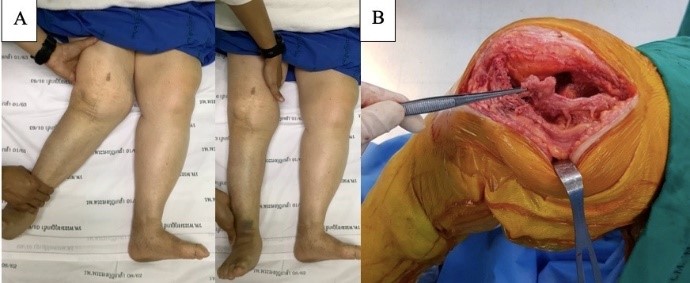Short-Term Global Instability and Genu Recurvatum Outcomes of Revision Total Knee Arthroplasty with Rotating-Hinged Knee Prosthesis
DOI:
https://doi.org/10.56929/jseaortho-023-0176Keywords:
rotating-hinged knee prosthesis, recurvatum after primary TKA, global instability, functional outcome, patient satisfactionAbstract
Purpose: Primary revision total knee arthroplasty (TKA) is associated with bone loss and ligamentous insufficiency. After TKA, patients may have global knee instability or genu recurvatum and require revision TKA with a rotating-hinged knee (RHK) prosthesis. However, several studies have reported variable outcomes. This study aimed to: 1) evaluate the outcomes of revision TKA with an RHK prosthesis; and 2) compare the outcomes and satisfaction of patients with global instability and genu recurvatum following revision TKA.
Methods: The cases of 18 patients (mean age, 71 ± 8.5 years; mean follow-up time, 24 months (range, 12–38 months) who underwent revision TKA with an RHK prosthesis in 2015–2018 were retrospectively reviewed. Patients were further classified into the global instability group (n=11), those who were diagnosed with periprosthetic joint infection (8 patients), TKA dislocation (2 patients), and periprosthetic fracture with a complete tear of the medial collateral ligament (1 patient); and the genu recurvatum group (n=7). Clinical evaluations were performed preoperatively, at 1 year postoperative, and at the last follow-up. Outcomes were assessed using the Knee injury and Osteoarthritis Outcome Score (KOOS), pain visual analog scale (VAS), range of motion (ROM), complications, and radiographic data. Patient satisfaction was assessed at the 1-year follow-up using a self-administered scale.
Results: Overall, the mean KOOS at the 1-year follow-up was significantly improved versus preoperative (71.39 ± 8.65 vs. 22.56 ± 11.58, p<0.001). The mean 1-year postoperative KOOS (50 vs. 47, p=0.028), surgical satisfaction score (p=0.005), home activity satisfaction score (p=0.0029), and recreational activity satisfaction score (p=0.024) were significantly higher in the global instability versus genu recurvatum group, whereas the mean pain VAS score was significantly higher in the global instability versus genu recurvatum group (6 vs. 4, p=0.037). The mean ROM improved from 30° to 90° in the global instability group and from -20° to 0° in the genu recurvatum group. No surgical complications or signs of prosthesis loosening were observed.
Conclusions: Revision TKA with an RHK prosthesis showed better functional outcomes in patients with global instability versus genu recurvatum. Furthermore, patients with global instability showed higher satisfaction with surgery, home, and recreational activities than those with genu recurvatum.
Metrics
References
Kurtz S, Ong K, Lau E, et al. Projections of primary and revision hip and knee arthroplasty in the United States from 2005 to 2030. J Bone Joint Surg Am 2007;89:780-5. DOI: https://doi.org/10.2106/JBJS.F.00222
Postler A, Lützner C, Beyer F, et al. Analysis of total knee arthroplasty revision causes. BMC Musculoskelet Disord 2018;19:55. DOI: https://doi.org/10.1186/s12891-018-1977-y
McAuley Jp, Engh GA. Constraint in total knee arthroplasty: when and what?. J Arthroplasty 2003;18(3 Suppl 1):51-4. DOI: https://doi.org/10.1054/arth.2003.50103
Barrack RL. Evolution of the rotating hinge for complex total knee arthroplasty. Clin Orthop Relat Res 2001;(392):292-9. DOI: https://doi.org/10.1097/00003086-200111000-00038
Pour AE, Parvizi J, Slenker N, et al. Rotating hinged total knee replacement: use with caution. J Bone Joint Surg Am 2007;89:1735-41. DOI: https://doi.org/10.2106/JBJS.F.00893
Rodriguez-Merchan EC. Total knee arthroplasty using hinge joints: Indications and results. EFORT Open Rev 2019;4:121‐32. DOI: https://doi.org/10.1302/2058-5241.4.180056
Pasquier G, Ehlinger M, Mainard D. The role of rotating hinge implants in revision total knee arthroplasty. EFORT Open Rev 2019;4:269-78. DOI: https://doi.org/10.1302/2058-5241.4.180070
Cottino U, Sculco PK, Sierra RJ, et al. Instability After Total Knee Arthroplasty. Orthop Clin North Am 2016;47:311-6. DOI: https://doi.org/10.1016/j.ocl.2015.09.007
Petrie JR, Haidukewych GJ. Instability in total knee arthroplasty : assessment and solutions. Bone Joint J 2016;98-B(1 Suppl A):116-9. DOI: https://doi.org/10.1302/0301-620X.98B1.36371
Jones RE, skedros Jg, Chan aJ, et al. Total knee arthroplasty using the S-ROM mobile-bearing hinge prosthesis. J Arthroplasty 2001;16:279-87. DOI: https://doi.org/10.1054/arth.2001.21498
Hernandez-Vaquero D, Sandoval-Garcia MA. Hinged total knee arthroplasty in the presence of ligamentous deficiency. Clin Orthop Relat Res 2010;468:1248-53. DOI: https://doi.org/10.1007/s11999-009-1226-7
Angelini FJ, Helito CP, Veronesi BA, et al. Knee arthroplasty revision with a constrained implant using hinge and rotating tibial basis. Acta Ortop Bras 2016;24:22-6. DOI: https://doi.org/10.1590/1413-785220162401153984
Chang MJ, Lim H, Lee NR, et al. Diagnosis, causes and treatments of instability following total knee arthroplasty. Knee Surg Relat Res 2014;26:61-7. DOI: https://doi.org/10.5792/ksrr.2014.26.2.61
A Siddiqui MM, Yeo SJ, Sivaiah P, et al. Function and quality of life in patients with recurvatum deformity after primary total knee arthroplasty: a review of our joint registry. J Arthroplasty 2012;27:1106-10. DOI: https://doi.org/10.1016/j.arth.2011.10.013
Abdel MP, Haas SB. The unstable knee: wobble and buckle. Bone Joint J 2014;96-B (11 Supple A):112-4. DOI: https://doi.org/10.1302/0301-620X.96B11.34325
Giori NJ, Lewallen DG. Total knee arthroplasty in limbs affected by poliomyelitis. J Bone Joint Surg Am 2002;84:1157-61. DOI: https://doi.org/10.2106/00004623-200207000-00010
Erceg M, Rakić M. Genu recurvatum as a complication after total knee arthroplasty. Acta Clin Croat 2012;51:265-8.
Chaipinyo K. Test-retest reliability and construct validity of Thai version of Knee Osteoarthritis Outcome Score (KOOS). Thai J Physical Therapy 2009;31:67-76.
Jorn LP, Johnsson R, Toksvig-Larsen S. Patient satisfaction, function and return to work after knee arthroplasty. Acta Orthop Scand 1999;70:343-7. DOI: https://doi.org/10.3109/17453679908997822
Mahomed N, Gandhi R, Daltroy L, et al. The Self- Administered Patient Satisfaction Scale for primary hip and knee arthroplasty. Clin Orthop Relat Res 2010;468:57-63.
P Neumann DR, Hofstaedter T, Dorn U. Follow-up of a modular rotating hinge knee system in salvage revision total knee arthroplasty. J Arthroplasty 2012;27:814-9. DOI: https://doi.org/10.1016/j.arth.2011.08.015
Bistolfi A, Massazza G, Rosso F, et al. Rotating-hinge total knee for revision total knee arthroplasty. Orthopedics 2012;35:e325-30. DOI: https://doi.org/10.3928/01477447-20120222-34
Kearns SM, Brian MC, Bohl dd, et al. Rotating hinge implants for complex primary and revision total knee arthroplasty. J Arthroplasty 2018;33:766-70. DOI: https://doi.org/10.1016/j.arth.2017.10.009
Deehan DJ, Gangadharan R, Malviya A, et al. Anterior knee symptoms after S-ROM hinge implantation. Bull Hosp Jt Dis (2013) 2014:72:167-72.

Downloads
Published
How to Cite
Issue
Section
License
Copyright (c) 2022 The Royal College of Orthopaedic Surgeons of Thailand

This work is licensed under a Creative Commons Attribution-NonCommercial 4.0 International License.






